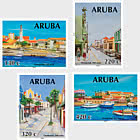Birds are vertebrates, with a backbone and skeleton, although some of the bones are hollow to keep the bird light. Their forelimbs have the same bones as the human arm, but they are highly modified to form the structure for wings. Some of the bones in the wrist and fingers are fused together for extra strength. Birds are warm blood and are the only animals that have feathers. All birds lay eggs with hard, waterproof shells, which they create nests for.
Stamp 50c-Tricoloured Heron-Egretta tricolor
It is a medium sized slender bird with long legs, neck, and bill. Legs are yellow in non-breeding season, and pink in the breeding season. The long and pointed bill is yellow with a black tip in non-breeding season. In breeding season the yellow turns to blue.
It is often seen wading belly-deep mainly in sub tropical coastal wetlands, mangrove swamps, inland around freshwater marshes, lakes or rivers. It nests in colonies, trees, mangroves, shrubs near water, usually on platforms of sticks in trees or shrubs. The tricolored heron stalks its prey in shallow or deeper water, often running as it does so. It eats fish, crustaceans, reptiles and insects.
The North American populations winter in Colombia and Ecuador. The resident breeders are found in the Gulf States of North America, northern Mexico, Central America and the Caribbean (incl. Aruba).
Stamp 85c - Snowy Egret / Egretta thula
The Snowy Egret is a medium size heron. They have a slim black bill and long black legs with yellow feet. The Snowy Egret eats fish, crustaceans, frogs, worms, snails, insects, small reptiles, mice. Snowy Egrets feed and nest colonially in mudflats, beaches, wetlands and mangroves along the coast and edges of rivers and lakes, and inland in wet agricultural fields. Snowy Egrets are permanent residents in most of South America and Central America, and migratory in North America, wintering in Mexico, Gulf Coast, Caribbean islands (incl. Aruba) and South America.
Stamp 90c-Roseate Spoonbill / Platalea ajaja
The Roseate Spoonbill is a sociable wading bird. The legs, bill, neck are elongated. Adult’s flight and body feathers range from pale, deep pink to bright magenta. The head is bare greenish, which is golden when breeding, and a white neck, back and breast (which when breeding has a tuft of pink feathers in the center). The bill is grey. Forages by wading in shallow muddy water and feed on small fish, aquatic invertebrates, shrimp, crayfish, crabs, aquatic insects (especially beetles), mollusks, slugs. It eats some plant material, including roots and stems of sedges. It nests in colonies, in mangroves, trees and shrubs.
In courtship, male and female first interact aggressively, later perch close together, present sticks to each other, cross and clasp bills. It is a resident breeder in South America mostly east of the Andes, and in coastal regions of the Caribbean, including Aruba, Central America, Mexico, the Gulf Coast of the United States and on central Florida's Atlantic coast.
Stamp 100c-Blue-winged Teal /Anas discors
Blue-winged Teal has brown eyes, black bill, and yellow legs with dusky webbed feet. Neck and head are usually dark grey with glossy purple feathers. Crown and throat are black. We can see broad white crescent bordered with black before the eye.
They are long distance migrants. They migrate from the Prairie Pothole Region to wintering areas in Florida, the Caribbean Islands (incl. Aruba), the Gulf Coast of Texas and Louisiana, Mexico and Central and South America, as far as Argentina
They build their nests on dry ground in grassy sites. These birds feed by dabbling in shallow water at the edge of marshes or open water. They mainly eat plants; their diet may include mollusks and aquatic insects.
Stamp 130c-Scarlet Ibis / Eudocimus ruber
This medium-sized wader is the only shore bird with red coloration in the world. Adults are bright red or scarlet, with somewhat lighter shading on the head, neck and underparts. Scarlet ibises have red bills and feet however the bill is sometimes blackish, especially toward the end. The long legs of this wading bird are pink, and the toes are partially webbed. They use their long, curved, pinkish-brown bill to probe the mudflats, shallow water and grasses in search of food, mainly crustaceans, small fish, aquatic insects, frogs, mollusks, worms, and snails. The large quantity of shrimp and other red shellfish produces a carotenoid which is the key component of the birds' red pigmentation.
These highly social birds form large breeding colonies, often in mangrove swamp. The bird is a very strong flyer; they are highly migratory and easily capable of long-distance flight. They move as flocks in a classic V formation. Flocks gather in wetlands and other marshy habitats, including mud flats, tropical grass lands, shoreline and rainforest, and inhabits tropical South America and islands of the Caribbean incl. Aruba.
Stamp 220c-Black Skimmer / Rynchops niger
Black skimmers are easily identifiable with predominant black markings on the top half of their bodies and white below. Skimmers have bright reddish orange colored webbed feet.The large red and black bill is knife-thin and the lower mandible is longer than the upper. The bird drags the lower bill through the water as it flies along, hoping to catch small fish. It feeds mostly on small fish that lives just below the surface of water and it also eats some small crustaceans. Black skimmers are a migratory species found along the Atlantic and Pacific coast of North and South America. Individuals of North America winter in South America and the Caribbean (incl. Aruba). Individuals of South America migrate to winter further North in the continent, as far as Costa Rica.
Stamp 250c- Ruby-topaz Hummingbird / Chrysolampis mosquitus
It is a very small hummingbird and the average adult is 8.1 cm long. The Ruby Topaz has a brilliant ruby crown and nape, iridescent golden orange throat and breast and bright orange tail. The male has green-glossed dark brown upperparts and underparts, while the female bronze-green upperparts and pale grey underparts. The food of this species is some small insects and nectar, taken from a wide variety of flowering trees, shrubs or cacti. The Ruby Topaz breeds in the Lesser Antilles (incl. Aruba) and tropical northern South America, from Colombia, Venezuela and the Guyanas, south to Central Brazil, a northern Bolivia and southern Panama.
Stamp 325c-Whistling Heron / Syrigma sibilatrix
This bird is named for its distinctive high pitched calls. It is a medium-sized grey heron with a strikingly colored yellow gold chest and neck. The crown of the adult is dark to slate black featuring several distinctive elongated black plumes, tipped with white or yellow. Unlike other herons, in flight it has fast, duck-like wingbeats and usually does not retract its neck fully. This species eats any small dryland and marsh animals it can catch or even pirate. It often holds still but also walks very slowly and may use more active techniques, even running after prey or catching flying insects (notably dragonflies) from a standing position.
It may allow humans to approach fairly closely rather than leave a good feeding spot. It typically feeds alone or in pairs, but is sometimes seen in groups up to 100, especially before roosting for the night.
The Whistling Heron is endemic to South America, where it occupies two disjunctive regions.
It is migratory in northeast Venezuela, and they are sighted in Aruba wetlands.




































